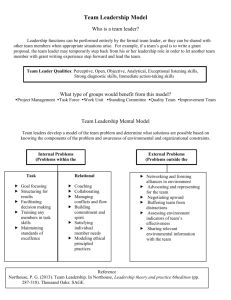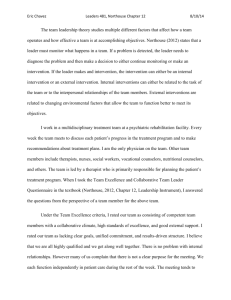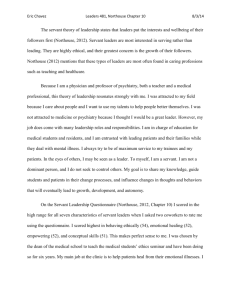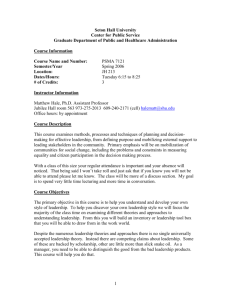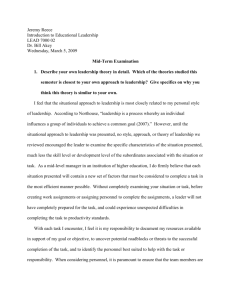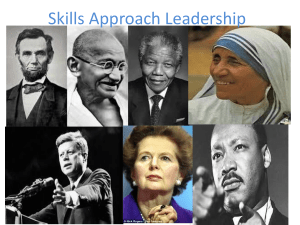Case 2: 1st Federal Team Reports Due
advertisement
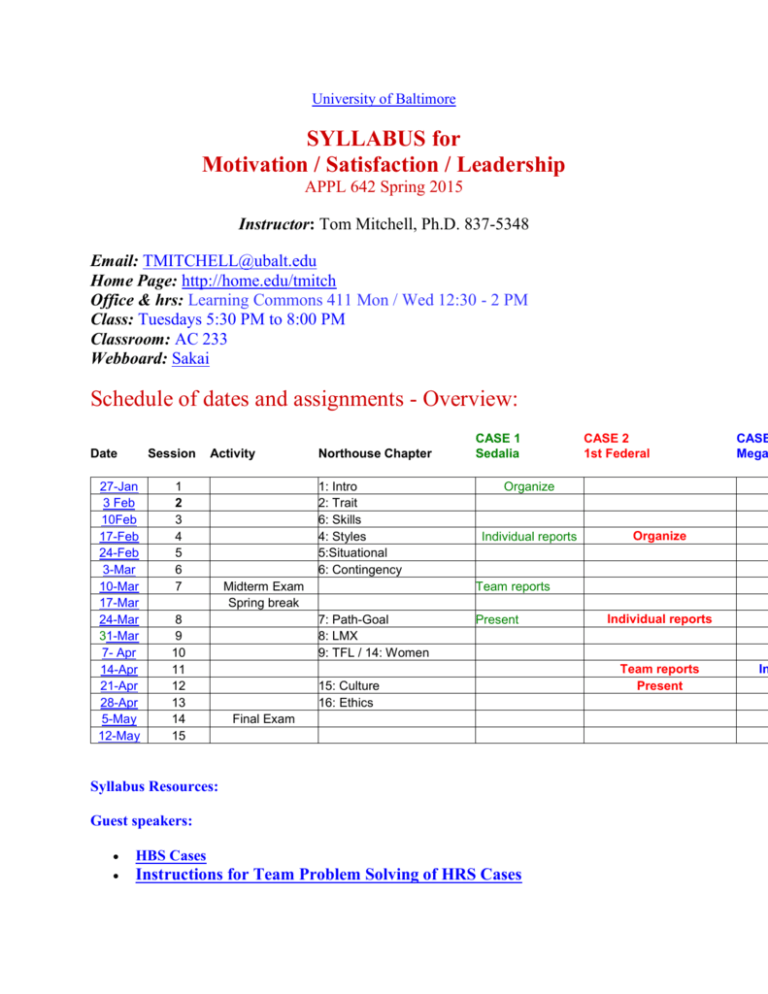
University of Baltimore SYLLABUS for Motivation / Satisfaction / Leadership APPL 642 Spring 2015 Instructor: Tom Mitchell, Ph.D. 837-5348 Email: TMITCHELL@ubalt.edu Home Page: http://home.edu/tmitch Office & hrs: Learning Commons 411 Mon / Wed 12:30 - 2 PM Class: Tuesdays 5:30 PM to 8:00 PM Classroom: AC 233 Webboard: Sakai Schedule of dates and assignments - Overview: Date Session 27-Jan 3 Feb 10Feb 17-Feb 24-Feb 3-Mar 10-Mar 17-Mar 24-Mar 31-Mar 7- Apr 14-Apr 21-Apr 28-Apr 5-May 12-May Activity 1 2 3 4 5 6 7 8 9 10 11 12 13 14 15 Northouse Chapter 1: Intro 2: Trait 6: Skills 4: Styles 5:Situational 6: Contingency Midterm Exam Spring break CASE 1 Sedalia CASE 2 1st Federal CASE Mega Organize Individual reports Organize Team reports 7: Path-Goal 8: LMX 9: TFL / 14: Women Present 15: Culture 16: Ethics Final Exam Syllabus Resources: Guest speakers: HBS Cases Instructions for Team Problem Solving of HRS Cases Individual reports Team reports Present In Team Case Assignments Article Questions I. Descriptive Information A. Catalog description: A critical examination of the interactive effects of personal and organizational variables on human behavior as reviewed in work group structure, accommodation to change, interpersonal perception, and problem solving behavior. Factors considered include emergent group leadership, managerial, motivational, and personality interactions. B. Course description: Using motivation as a central concept, this course will provide the student with an in-depth understanding of how person and environmental factors interact to influence organizational behavior. Predominant motivational theories will be used to explain how group dynamics and cross-cultural influences affect motivation, and how attitudes toward the job and the organization relate to performance. Students will learn to apply motivational techniques to improve work performance and satisfaction. II. Objectives of course: To enable the student to: (1) Analyze causes for organizational behavior and develop effective ways to improve work performance. (2) Gain an experiential understanding of how group activity may facilitate or inhibit work performance. (3) Improve their ability to work effectively with others to solve problems related to organizational behavior. III. Class format: Assigned readings will be discussed. Ideas and conclusions generated from the discussions will be used by groups to solve problems presented in case studies. Case studies will be discussed in class and on Sakai IV Texts required: Northouse, P. G. (2013) Leadership: Theory and Practice. 6th ed. Pub: Sage ISBN: 978 1-4522-0340-9 or 5th edition ISBN 978-1-4129-7488-2 (pbk.) either one will work Student Resources: http://www.sagepub.com/northouse5e Harvard Case Studies (3) (to be distributed in class) V. Course requirements for each student: *Posting of comments on Sakai for assigned readings (Instructions) Submission of Individual Reports for each of the three Harvard Business School cases (Instructions). Submission of a Team report for each of the three HBS cases (instructions). Completion of the mid-term and final exams. * NOTE: Failure to submit the summaries and questions may result in a 10% grade decrement VI. Assessment: Exams: Two written exams (essay and short answer): midterm and final exam covering course content Individual and Team case reports (instructions) Note: Participation for Sakai article discussions is essential for completing course completing a passing grade, but will not be graded 40 % 2 Exams (20% each) 30 % 3 Individual case data analysis reports (10% each) 30 % 3 Team case reports (10% each) 100% TOTAL Grade Scale: 90-100 A; 85-89 B+; 80-84 B; 75-79 C+; 70 C Additional online syllabus Resources: How to write an executive summary PDF file Journal of Applied Psychology Value Based Management site (information on all sorts of management techniques, etc.) Management Speak (learn how to understand your boss) Readings in Organizational Psychology (J. LeBreton, E. Tenn State) Session / Date / Chapters / Case Activity / Readings (see also Bibliography at end) (1) Jan 27 Discussion of syllabus / Group problem solving: Harvard cases -> Case I Sedalia: Organize Teams Northouse Chapter 1 Introduction Review of motivational theories U. Toronto Motivation theory (Instructor: Chun Wei Choo Paul Spector's Job Satisfaction Scale Info JSS on line (2) Feb 3 Northouse Chapter 2 Trait Approach Discuss Sedalia Data Analyses Steers, et al. (2004). Introduction to special topic forum: The future of work motivation theory. Academy of Mgt Rev. 29(3) 379-387 Article questions Latham & Pinder (2005). Work motivation theory and research at the dawn of the 21st century. Annual Rev. of Psy., 56, 485-516. Article questions Locke & Latham (2004) What should we do about motivation theory? Six recommendations for the 21st century. Acad Mgt Rev. Article Questions McGrath outline of trait paradigm (3) Feb 10 Northouse Chapter 3 Skills Approach LOQ site http://www.creativeorgdesign.com/testpages/loq.htm (distribute LOQ questionnaire) Leadership SKAs (Johnson, Schneider, Oswalk (1997) Toward a Taxonomy of Managerial Performance Profiles. Human Performance, 10(3), 227-250. Self-determination theory General Causality Scale (Deci & Ryan) JCM ppoint JDS/JRF for Hackman &Oldham JCM by Andrew Loignon - .xlsx file Not So Fast (Taylor and Gilbreths' legacy) (no summary or questions) (4) Feb 17 Northouse Chapter 4 Style Approach Article Questions -> Case 1: Sedalia Individual Reports Due -> Case 2: 1st Federal Organize Teams (LOQ): Report results and discuss (JCM): Report results and discuss Ryan & Deci (2000) Self-Determination Theory and the Facilitation of Intrinsic Motivation, Social Development, and Well-Being. Am Psy. Vol. 55 I Article Questions NOTE: For review Deci, E., Koestner, R. & Ryan (1999) meta-analytic review of experiments examining the effects of extrinsic rewards on intrinsic. Psych Bull. Vol. 125 Article Questions Inceoglu, I. et al. (2014). Age differences in work motivation: Same in different countries? 29th Annual SIOP conference, Honolulu HA. Bastelli, A., Montani, F., & Ordoardi, C. (2013). The impact of feedback from job autonomy in the relationship between dispositional resistance t change and innovative work behavior. European Journal of Work and Organizational Psychology, 22, 1, 26-41. Liking Work Really Matters NYT 9-45-2014 Paul O'Keete Pink, D. "More than a paycheck" WSJ 2-2-10 (5) Feb 24 Northouse Chapter 5 Situational Approach M. Csikzentmihalyi, (1999). If we are so rich, why aren't we happy? American Psychologist. Article questions Locke & Latham (2002) Building a practically useful theory of goal setting and task motivation: A 35-year odyssey American psychologist Article Questions bonus article (please do not read): WSJ (2/19/2008): Modern Conundrum: When Work's Invisible, So Are Its Satisfactions Motivation and Leadership from a Chinese Perspective (6) Mar 3 Northouse Chapter 6 Contingency Theory Contingency models of leadership -> Case 3: Megalith Organize Teams Midterm Review (7) Mar 10 *** Midterm Exam *** Northouse Chapters 1-6; Articles assigned -> Case 1: Sedalia Team Reports Due Mar 17 *** Spring Break ***** (8) Mar 24 Northouse Chapter 7 Path-Goal Theory (p125-146) > Case 1: Sedalia Team Presentations -> Case 2: 1st Federal Individual Reports Due Judge et al. (2002). Relationship of personality to performance: Motivation: A metaanalytic review. Journal of Applied Psychology, 87, 797-807. Article Questions Judge, T., Bono, E., Erez, A., & E. Locke (2005) Core Self-Evaluations and Job and Life Satisfaction: The Role of Self-Concordance and Goal Attainment. Journal of Applied Psychology, 90. Article Questions Salgado, J. F., & Tauriz, G. (2014) The Five-Factor Model, forced-choice personality inventories and performance: A comprehensive meta-analysis of academic and occupational validity studies. European Journal of Work and Organizational Psychology, 23, 1, 3-30. Ipsative v. Normative Personnel Metrics (9) Mar 31 Northouse Chapter 8 Leader-Member Exchange Theory Yoav Vardi & Yoash Weiner (1996) Misbehavior in Organizations; A motivational Framework Organization Science. 7, (2) Article Questions M. Mount et al. (2006). Relationship of personality traits and counterproductive work behaviors: The mediating effects of job satisfaction. Personnel Psychology Article Questions Johnson, Lanaj, & Barnes (2014). The good and bad of being fair: Effects of Procedural and Interpersonal Justice on Regulatory Resources. J. of Applied Psychology, Jan. (10) Apr 7 Northouse Chapter 9 Transformational Leadership Northouse Chapter 14 Women and Leadership > Case 3: Megalith Individual Reports Due Employee Discretion: When. Where, and How (B. Thompson) e -article Rogelberg, S. G. (2007). Job satisfaction & job satisfaction measurement. Encyclopedia of I & O Psych, p. 410-413 Article Questions T. Judge, Heller, Mount (2002) Five-factor model of personality and job satisfaction: A meta-analysis. J. of Applied Psych, 87, Article Questions Barbier, Hansez, Chmiel, & Demerouti (2014). Performance expectations, personal resources, and job resources: How to they predict work engagement? European Journal of Work and Organizational Psychology. (NOTE: following articles not required for online discussion) Engage Employees and Boost Performance HayGroup 2001 Article Question Peter Warr (2007). Jobs and Happiness. The Industrial Psychologist, 44, p. 19 (11) Apr 14 Northouse Chapter 15 Culture and Leadership > Case 2: 1st Federal Team Reports Due Currall, Towler, Judge, & Kohn (2005) Pay satisfaction and organizational outcomes. P Psych, 58, Article Questions Colella, et al. (2007). Exposing pay secrecy. Academy of Management Review, 32, 5571 Article Questions President Obama 77 cents pay gap for women? Wash Post 4-12-14 (12) Apr 21 -> Case 2: 1st Federal Team Presentations -> Case 3: Megalith Team Reports due McBriarty, M. A. (1988). Performance appraisal; Some unintended consequences. Public Personnel Management, 17, 421-434 Article Questions Schleicher, D.J., Bull, R. A., & Green, S.G. (2009). Rater reactions to forced distribution rating systems. Journal of Management, 35, 899-927. Bonus not a Cure-all Performance bonus out of reach? Move the target Animals seem to have an inherent sense of fairness and justice WSJ 2006 (13) Apr 28 Northouse Chapter 16 Leadership Ethics -> Case 3: Megalith Team Presentations Frese, Kring, Soose & Zempel (1996). Personal Initiative at Work: Differences between East and West Germany. Acad Mgt J. V. 39(1), 37-53. Article Questions Judge, Bono, LLies, & Gerhardt (2002). Personality and Leadership: A qualitative and quantitative review. JAP, 87, 765-780. Hogan & Hogan (2010). Abstracting Leadership. PTC/MW Quarterly, March, 1, 6-7. (14) May 5 *** Final Exam *** Northouse Chapters 7-9; 14-16; Articles Assigned Judge, T., et al. (2002). Job satisfaction: A cross-cultural review. Handbook of Industrial, Work and Organ Psych, V. 2 For reference only *** not required reading
